Cooccurrence of Metastatic Papillary Thyroid Carcinoma and Salmonella Induced Neck Abscess in a Cervical Lymph Node
Abstract
Cervical lymph node metastasis is common in patients with papillary thyroid carcinoma (PTC). Salmonella species are rarely reported as causative agents in focal infections of the head and neck. The cooccurrence of lymph node metastasis from PTC and a bacterial infection is rare. This report describes a 76-year-old woman with a cervical lymph node metastasis from PTC and Salmonella infection of the same lymph node. The patient presented with painful swelling in her left lateral neck region for 15 days, and neck ultrasonography and computed tomography showed a cystic mass along left levels II–IV. The cystic mass was suspected of being a metastatic lymph node; modified radical neck dissection was performed. Histopathological examination confirmed the presence of PTC in the resected node and laboratory examination of the combined abscess cavity confirmed the presence of Salmonella Typhi. Following antibiotic sensitivity testing of the cultured Salmonella Typhi, she was treated with proper antibiotics. Cystic lesions in lymph nodes with metastatic cancer may indicate the presence of cooccurring bacterial infection. Thus, culturing of specimen can be option to make accurate diagnosis and to provide proper postoperative management.
1. Introduction
PTC is the most common well-differentiated cancer of the thyroid gland, accounting for 80–85% of well-differentiated thyroid malignancies [1]. PTCs generally show a good prognosis, although they metastasize to regional lymph nodes in 30–80% of patients [2].
The simultaneous presence of infection and metastasis in the same lymph node is rare, with most cases observed in patients with tuberculosis [3–8]. This report describes a patient with a PTC-derived metastasis coexisting with an abscess due to Salmonella infection.
2. Case Presentation
A 76-year-old female presented with painful swelling in the left lateral neck region for 15 days. There was no erythema or heating sensation on neck area, and she had no symptoms of fever. Ten months earlier, she had undergone total thyroidectomy with central neck lymph node dissection due to PTC (T3N1aM0 by American Joint Committee on Cancer/International Union against Cancer Staging System 7th Edition), followed by radioactive iodine therapy and maintenance treatment with levothyroxine.
Thyroid function tests showed mildly suppressed thyrotropin-stimulating hormone (TSH; 0.01 mIU/L; normal range, 0.27–4.2 mIU/L) and elevated free thyroxine (fT4; 2.12 ng/dL; normal range, 0.93–1.70 ng/dL) concentrations. Her white blood cell and neutrophil counts were normal. No pathogens were cultured from her blood, stool, urine, or sputum.
Neck ultrasonography revealed a large heterogeneous echoic (cystic) mass in the left lateral neck (Figure 1) and computed tomography revealed a 3.3 × 5.6 cm sized thick-walled cystic lesion along left levels II, III, and IV (Figure 2). Cytologic examination of the dark brown colored fluid collected from the lesion by fine-needle aspiration showed many neutrophils and macrophages in necrotic background, but there was no evidence of malignancy (Figure 3). However, the mass was suspected of being a metastatic lymph node and was resected.
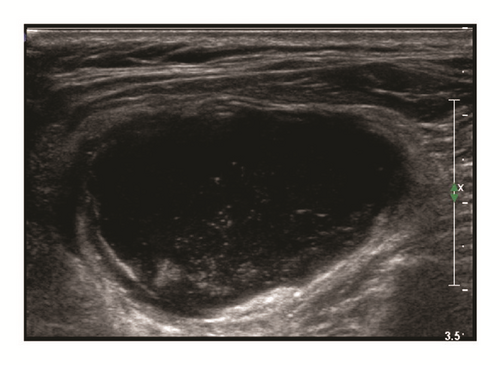
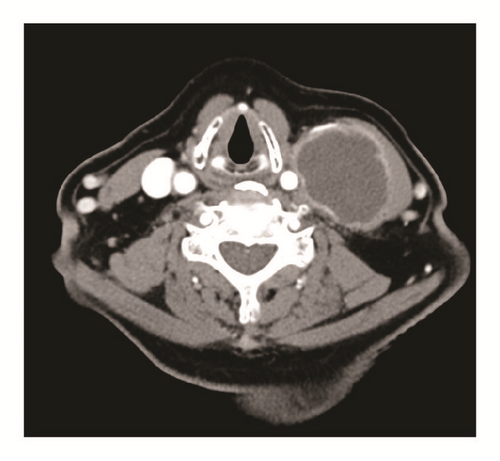
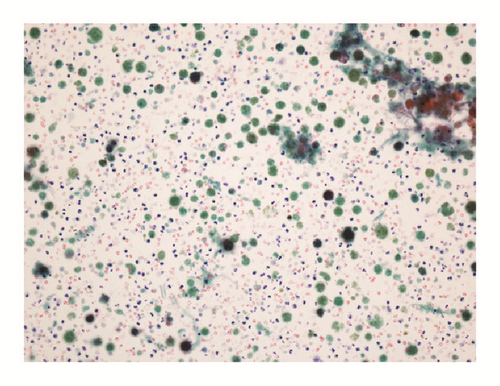
Intraoperative examination showed that mass was encapsulated and very highly adhesive to the internal jugular vein and around the tissue. There were no other abnormally enlarged lymph nodes. The mass contained dark brown colored fluid and some debris. Microscopic examination of the lymph node mass showed massive necrosis and immunohistochemistry clearly showed that the mass was a metastatic papillary carcinoma (Figure 4). Culture of the fluid showed the presence of Salmonella Typhi.
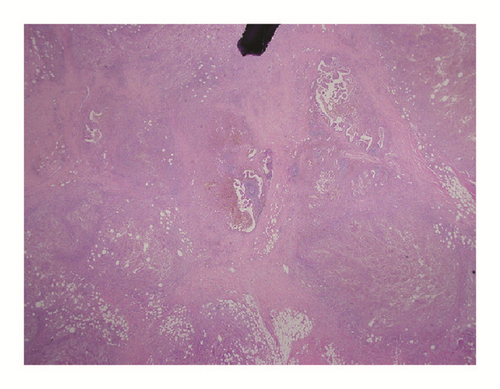
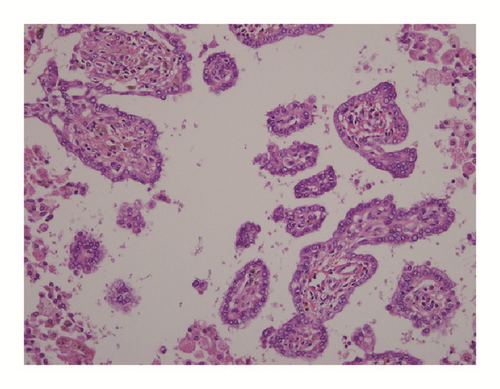
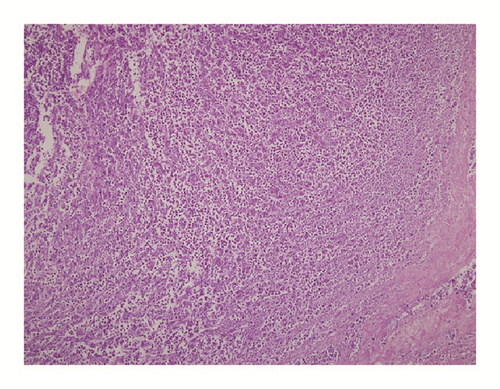
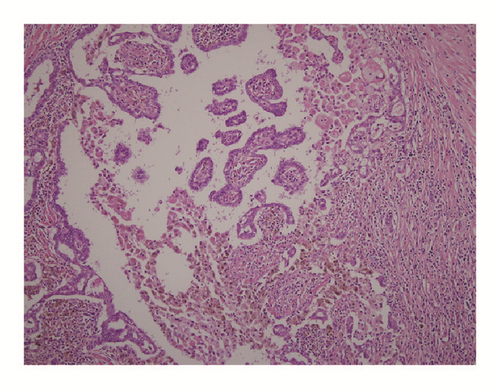
No postoperative complications occurred. The patient was treated with intravenous cephalosporin for 6 days; following antibiotic sensitivity testing of the cultured Salmonella Typhi, she was switched to oral ciprofloxacin for 7 days. Regular follow-up examinations have shown no evidence of additional metastasis, recurrence of metastasis, or residual infection.
3. Discussion
Nodal metastasis of PTC can appear as a solid or cystic mass. Approximately 40% of lymph node metastases from PTCs tend to cavitate via complete cystic degeneration [9]. This cystic lymph node metastasis may therefore have been misinterpreted as a benign cervical cystic mass.
Salmonella is a nonencapsulated Gram negative motile bacillus. Salmonella infection may lead to typhoid fever, enterocolitis, or bacteremia with focal lesions in various parts of the body [10, 11].
Head and neck infection normally arise from Streptococcus, Staphylococcus, Haemophilus, or other anaerobic species. Salmonella infections of the head and neck are usually found in the tonsils, middle ear, and parotid gland but are rarely reported in neck abscess [10–13]. In one case report, Salmonella Typhi was isolated from the blood of a 20-year-old Korean woman with persistent fever, headache, myalgia and cervical lymphadenopathy, with this patient finally diagnosed with necrotizing lymphadenitis due to Salmonella Typhi [14].
Conventional treatment of a Salmonella neck abscess includes incision and drainage, along with treatment with appropriate antibiotics [15]. Recently, quinolones and third-generation cephalosporins were shown to be effective as first-line treatment against Salmonella [16].
Lymphadenitis has been reported to be an extraintestinal manifestation of Salmonella infection in patients with malignancy. Salmonella was isolated from a supraclavicular node in a patient with stomach cancer and from an axillary lymph node in a patient with reticulum cell sarcoma [17]. Salmonella Braenderup was isolated from a cervical lymph node of a patient with Hodgkin’s lymphoma [18], and group D nontyphoidal Salmonella was isolated from a cervical lymph node, positive for diffuse large B cell lymphoma [19]. In the present case, Salmonella Typhi was isolated from the same lesion containing a metastatic PTC; to our knowledge, this is first case report describing the isolation of Salmonella from a metastatic lymph node associated with PTC.
In summary, a Salmonella species was able to infect a cervical lymph node and progress to neck abscesses in patients with PTC, and cervical lymph node metastasis is common in patients with PTC. The presence of an abnormally enlarged neck mass in a patient with PTC may suggest the cooccurrence of Salmonella infection and malignancy in the same lesion. Culturing of the specimen may enhance diagnostic accuracy and providing proper postoperative management.
Competing Interests
The authors have declared that there is no conflict of interests regarding the publication of this paper.




